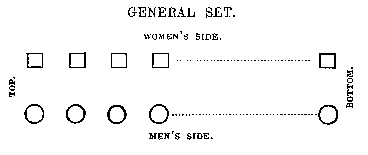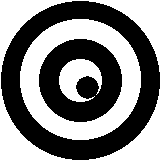The Country Dance is performed by any equal numbers of men and women, not fewer than six
in all. The performers take partners and stand in parallel lines, the men on one side
facing the women on the other, each dancer standing opposite his or her partner. This
formation is called the General Set and is depicted in the following diagram
( = woman;
= woman;  = man):
= man):

The distance between the lines should be approximately five feet, and between the couples about two and a half feet. The top of the General Set is that end which is nearest the music, and, if there is one, the audience; it is on the right of the women, and on the left of the men.
A Country Dance consists of an indefinite number of repetitions of a series of figures, which vary both in number and character in different dances. This series of figures is called the complete figure: while the subsidiary movements of which it is compounded are called ordinary figures or figures. Each performance of the complete figure is called a round.
Country Dance figures are very numerous. They vary in length, character, and the number of dancers that take part in their performance. Each complete figure, however, must contain, inter alia, what is called a progressive figure, the effect of which is to change the order and position of some or all of the couples. Consequently, as the dance proceeds, the couples are continuously changing places, in an ordered way, some moving up and others down the General Set.
This progressive movement is the essential and distinctive, as it is the invariable, feature of the Country Dance. As an artistic device, its function is to link together and so give continuity, to what would otherwise be a series of disconnected and monotonous repetitions.
There are two ways in which the progressive movement is effected, giving rise to two different types of dance. These we shall call, respectively, the whole-set and minor-set dance. The whole-set dance, as the simpler of the two, will first engage our attention.
Page transcribed by Hugh Stewart
